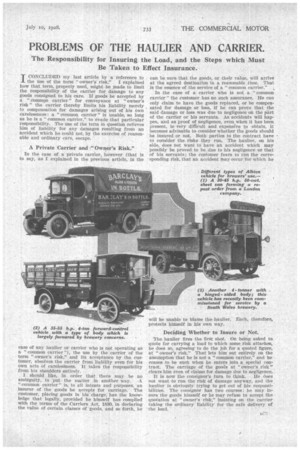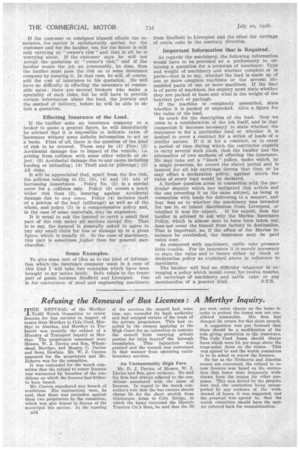PROBLEMS OF THE HAULIER AND CARRIER.
Page 107

Page 108

If you've noticed an error in this article please click here to report it so we can fix it.
The Responsibility for Insuring the Load, and the Steps which Must Be Taken to Effect Insurance.
T CONCLUDED my last article by a reference to 1 the use of the term "owner's risk." I explained how that term, properly used, might be made to limit the responsibility of the carrier for damage to any goods consigned to his care. If goods be accepted by a "common carrier" for conveyance at "owner's risk" the carrier thereby limits his liability merely to compensation for damages arising out of his own carelessness: a "common carrier" is unable, so long as he is a "common carrier," to evade that particular responsibility. The use of the term in question relieves him of liability for any damages resulting from an accident which he could not, by the exercise of reasonable and ordinary care, escape.
A Private Carrier and " Owner's Risk."
In the case of a private carrier, however (that is to say, as I explained in the previous article, in the case ofany haulier or carrier who is not operating as a "common carrier "), the use by the carrier of the term "owner's risk," and its acceptance by the customer, absolves the carrier from liability even for his own acts of carelesSness.. It takes the responsibility from his shoulders entirely.
I should like, in order that there may be no ambiguity, to put the matter in another Way. -A "common carrier" is, to all intents and purposes, an insurer of the goods he accepts for carriage. The customer, placing goods in his charge; has the knowledge that legally, provided he himself has. complied with the 'terms of the Carriers Act. 1830, in declaring the value of certain claSses Of goods, and so forth, he
can be sure that the goods, or their value, will arrive at the agreed destination in a reasonable time. That is the essence of the service of a "common carrier." _ In the case of a carrier who is not a "common carrier" the customer has no such assurance. He can only claim to have the goods replaced, or be compensated for damage or loss, if he can prove that the said damage or loss was due to negligence on the part of the carrier or his servants. As accidents will happen, and as proof of negligence, even when it has been present, is very difficult and expensive to obtain, it becomes advisable to consider whether the goods should be insured or not. Both parties to the contract have to consider the risks they run. The haulier, on his side, does not want to have an accident which may possibly be proved to be .due to his negligence or that of his servants; the customer -fears to run the corresponding risk, that an accident May occur for which he will be unable to blame thehaulier. Each, therefore, protects himself in his own way.
Deciding Whether to Insure or Not.
The haulier fires the first shot. On being asked to quote for carrying a load to which some risk attaches, be does so, agreeing to do the job for a quoted figure, at ." owner's risk." That lets .him out entirely on the assuMption that he is not a " common carrier," and he ceases to be such when he enters into a special contract. The carriage of the goods at "owner's risk" clears hina even of claims for damage due to negligence.
It isnow the consignor's turn to think. Ile does not want to run the risk of damage anyway, and the , haulier is obviously" trying to get out of his responsibilities. The consignor has two courses: he may insure the goods himself orhe may refuse to accept the quotation at " owner's risk," insisting on the carrier taking the ordinary liability for the safe delivery of the' load.'
If the customer or consignor himself effects the insurance, the matter is satisfactorily settled for the customer and for the haulier, too, for the latter Is still only carrying at "owner's risk" and that is all he is worrying about. If the customer says he will not accept the quotation at "owner's risk," and if the haulier wants the job as, presumably, he does, then the haulier must pass the risk on to some insurance company by insuring it. In that case, he will, of course, add the cost of insurance to his quotation. He will have no difficulty in effecting the insurance at reasonable rates ; there are several brokers who make a speciality of such risks, but he will have to provide certain information about the load, the journey and the method of delivery, before he will be able to obtain a quotation.
Effecting Insurance of the Load.
If the haulier asks an insurance company or a broker to quote a general figure, he will immediately be advised that it is impossible to indicate rates of Insurance without some definite information to act as a basis. First of all, there is the question of the kind of risk to be covered. These may be (I) Fire; (2) Accidental damage due to impact of the vehicle, i.e. arising from collision with some other vehicle or object; (3) Accidental damage due to any cause including loading or unloading; (4) Theft and/or pilferage; (5) All risks.
It will be appreciated that, apart from the fire risk, the policies relating to (2), (3), (4) and (5) are or increasing importance. . Policy No. (2) is a special cover for a collision only. Policy (3) covers a much wider risk than (2), insuring against accidental damage due to any cause. Policy (4) includes theft of a portion of the load (pilferage) as well as of the whole, and policy (5) is a comprehensive policy and, in the case of some materials, may be expensive.
It is usual to ask the insured to carry a small first part of the risk under all sections except fire. That is to say, the insured is generally asked to agree to pay any small claim for loss or damage up to a given figure, which is usually £5. In the case of machinery, this part is sometimes .higher than for general merchandise.
Some Examples.
To give some sort of idea as to the kind of information which-the insurance company want in a case of this kind I will take two examples which have been brought to my notice lately. Both relate to the transport of gobds between Sheffield and Liverpool. One is for conveyance of steel and engineering machinery from Sheffield to Liverpool and the other for carriage of cattle cake in the contrary direction.
Important Information that is Required.
As regards the machinery, the following information would have to be provided as a preliminary to obtaining a quotation for a premium of insurance: Type and weight of machinery and whether complete, or in parts—that is to say, whether the load is made up of one or more complete machines or the several dissembled parts of one or more machines. If the load is of parts of machines, the enquiry must state whether they are packed or loose and what is the weight of the heaviest part or package. If the machine is completely assembled, state whether it is packed or unpacked. Give a figure for the value of the load.
So much for the description of the load. Now we come to a consideration of the job itself, and in that connection it becomes necessary to state whether the insurance is for a particular load or whether it is desired to cover a contract for a series of loads of a similar nature. If it is for a contract, or to cover a period of time during which the contractor expects to carry several such loads, then the haulier has the alternative of two methods of effecting the insurance. He may take out a ." block" policy, under which, by a single premium, he covers the stated period and is insured for all his carryings during that time, or he may effect a declaration policy, against which the value of every load would be declared.
A further question arose in connection with the particular enquiry which has instigated this article and the one preceding it on the same subject, as being in connection with loads for delivering to a seaport, and that was as to whether the machinery was intended for use in, or inland distribution from, Liverpool, or whether it was for export. If for export, then the haulier is advised to ask why the Marine Insurance Policy, which is almost sure to have been taken out, does not cover the transit from factory to destination. This is important, as, if the effect of the Marine insurance be overlooked, the insurance may be paid twice over.
As compared with machinery, cattle cake presents little trouble. For its insurance it is merely necessary to state the value and to insure either by block or declaration policy as explained above in reference to machinery.
The haulier will find no difficulty whatever in arranging a policy which would cover, for twelve months, all carryings of machinery and cattle cake or any merchandise of a general kind. S.T.R.












































































































































































